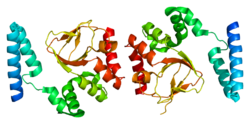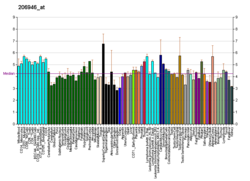HCN4
gène de l'espèce Homo sapiens
HCN4 est un canal ionique intervenant dans le courant if. Son gène est le HCN4 situé sur le chromosome 15 humain.
La mutation du gène peut être responsable d'une bradycardie[5], et parfois, d'une non compaction ventriculaire gauche[6] ou d'une dilatation de l'aorte ascendante[7]. Une autre mutation, avec gain de fonction, peut provoquer une tachycardie sinusale inappropriée familiale[8].
Notes et références modifier
- GRCh38: Ensembl release 89: ENSG00000138622 - Ensembl, May 2017
- GRCm38: Ensembl release 89: ENSMUSG00000032338 - Ensembl, May 2017
- « Publications PubMed pour l'Homme », sur National Center for Biotechnology Information, U.S. National Library of Medicine
- « Publications PubMed pour la Souris », sur National Center for Biotechnology Information, U.S. National Library of Medicine
- Nof E, Luria D, Brass D et al. Point mutation in the HCN4 cardiac ion channel pore affecting synthesis, trafficking, and functional expression is associated with familial asymptomatic sinus bradycardia, Circulation, 2007;116:463–470
- Milano A, Vermeer A, Lodder EM et al. HCN4 mutations in multiple families with bradycardia and left ventricular noncompaction cardiomyopathy, JACC, 2014;64:745-756
- Vermeer AM, Lodder EM, Thomas D et all. Dilation of the aorta ascendens forms part of the clinical spectrum of HCN4 mutations, 2016;67:2313-2315
- Baruscotti M, Bucchi A, Milanesi R et al. A gain-of-function mutation in the cardiac pacemaker HCN4 channel increasing cAMP sensitivity is associated with familial Inappropriate Sinus Tachycardia, Eur Heart J, 2017;38:280–288





